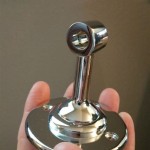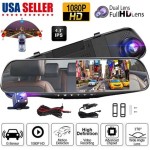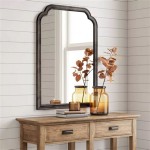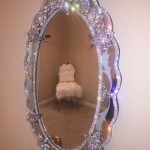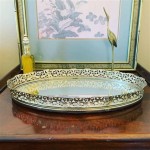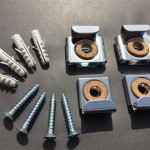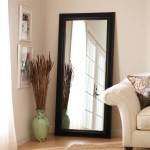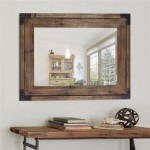Mirror TV Cover-Ups: Blending Technology and Aesthetics
Mirror TVs represent a convergence of technology and interior design, seamlessly integrating a functional television screen within a reflective surface. When the television is off, the unit appears as a standard mirror, adding to the ambiance of a room. When activated, the screen becomes visible through the mirrored glass, allowing for regular television viewing. However, the integration of this technology raises several design challenges, particularly concerning concealing the television components and creating a seamless aesthetic appearance. This article will explore the various cover-up techniques employed to hide the television components behind the mirror, the associated practical considerations, and how these techniques impact the overall viewing experience.
The core of a mirror TV lies in the specific type of glass used. Two-way mirrors, also known as one-way mirrors or surveillance mirrors, are specifically designed to reflect light on one side and transmit light on the other. In a mirror TV, the coated side faces outward, creating the reflective surface. The television screen is positioned behind this mirror. When the television is off, the ambient light is reflected by the mirror, obscuring the components behind it. When the television is turned on, the light emitted from the screen is strong enough to penetrate the mirror, making the display visible. The effectiveness of this effect relies heavily on the ambient light in the room versus the brightness of the television screen.
The construction of a mirror TV necessitates careful consideration of ventilation, wiring, and accessibility for maintenance. Proper ventilation is crucial to prevent the television from overheating, which can lead to component failure and reduced lifespan. Wiring must be neatly managed to avoid obstructions and ensure a clean, professional installation. Accessibility is essential for future repairs or upgrades to the television or its associated components. These practical considerations often dictate the specific cover-up methods employed.
Concealing the Television Components
The primary purpose of a mirror TV cover-up is to hide the television's internal components, ensuring that they are not visible through the mirror when the unit is off. This involves multiple layers of design and execution. Several methods are employed to achieve this objective, each with their own advantages and disadvantages.
One common technique involves creating a custom-built enclosure or recess within the wall. This enclosure houses the television and its wiring, providing a structured space that prevents the components from being seen through the mirror. The enclosure must be precisely measured to accommodate the television model and allow for sufficient ventilation. The depth of the recess is crucial to ensure the mirror sits flush with the wall, maintaining the seamless appearance crucial to the aesthetic.
Another method involves using a black backing material applied directly behind the mirror. This material absorbs any stray light that might otherwise penetrate the mirror and reveal the components behind it. The black backing also aids in enhancing the contrast of the television image when it is turned on. The choice of backing material is important; it should be non-reflective and heat-resistant to avoid damaging the television or the mirror over time. Felt, specialized black-out fabric, or even black-painted wood are commonly used.
Furthermore, strategically placed LED lighting can be used to enhance the mirror's reflective properties when the television is off. By directing light onto the mirror's surface, the reflective effect is amplified, further obscuring the components behind it. When the television is on, the LEDs can be dimmed or turned off to prevent them from interfering with the viewing experience. The placement and intensity of the LED lighting should be carefully considered to avoid creating unwanted glare or reflections.
Finally, framing the mirror TV can also serve as a cover-up mechanism. A well-designed frame can hide the edges of the mirror and any gaps between the mirror and the wall, creating a more polished and complete look. The frame can be made from various materials, such as wood, metal, or composite materials, and can be customized to match the décor of the room. The frame must be deep enough to accommodate the thickness of the mirror and the television, ensuring that it sits flush with the wall.
Practical Considerations for Installation
Installing a mirror TV involves several practical considerations that must be addressed to ensure a successful and long-lasting installation. These considerations include structural support, ventilation, wiring, and accessibility for future maintenance.
Structural support is crucial, particularly for larger mirror TVs. The weight of the television and the mirror can be significant, requiring adequate reinforcement of the wall to prevent sagging or damage. The wall studs must be properly located and reinforced to provide a secure mounting point for the television and the mirror. In some cases, it may be necessary to add additional support structures behind the wall to distribute the weight evenly.
Ventilation is essential to prevent the television from overheating. Televisions generate heat during operation, and if this heat is not properly dissipated, it can lead to component failure and reduced lifespan. When installing a mirror TV, it is important to ensure that there is adequate airflow around the television to allow heat to escape. This can be achieved by incorporating ventilation holes or fans into the enclosure or recess. The positioning of the ventilation openings should be carefully considered to prevent dust or debris from entering the enclosure.
Wiring must be neatly managed to avoid obstructions and ensure a clean, professional installation. All wiring should be routed through conduits or raceways to protect it from damage and to keep it organized. The wiring connections should be secure and properly insulated to prevent electrical hazards. Additionally, the wiring should be easily accessible for future maintenance or upgrades. Labeling the wires can also be beneficial for troubleshooting and future modifications.
Accessibility for future maintenance is a critical consideration that is often overlooked. Televisions and other electronic components are prone to failure, and it is important to ensure that they can be easily accessed for repairs or replacements. When designing the mirror TV enclosure or recess, it is important to incorporate access panels or doors that allow for easy access to the television and its components. These access points should be discreetly located to avoid detracting from the aesthetic appearance of the mirror TV.
Impact on Viewing Experience
The design and installation of a mirror TV can have a significant impact on the overall viewing experience. Factors such as mirror reflectivity, screen brightness, and viewing angle can all affect the quality of the image and the comfort of the viewer.
Mirror reflectivity is a crucial factor in determining the clarity and brightness of the television image. The mirror should have a high reflectivity to allow as much light as possible to pass through from the television screen. However, excessive reflectivity can also create glare, which can be distracting and uncomfortable for the viewer. The ideal balance is a mirror with high reflectivity but minimal glare. Anti-glare coatings can be applied to the mirror to reduce glare and improve the viewing experience.
Screen brightness is another important consideration. The television screen must be bright enough to overcome the reflectivity of the mirror and be visible in ambient lighting conditions. If the screen is not bright enough, the image may appear dim or washed out. The optimal screen brightness will depend on the size of the screen, the reflectivity of the mirror, and the ambient lighting conditions in the room. High-brightness LED televisions are often used in mirror TV applications to ensure a clear and vibrant image.
Viewing angle can also affect the viewing experience. The ideal viewing angle is the angle at which the viewer can see the entire screen without distortion or loss of brightness. Televisions typically have a limited viewing angle, and if the viewer is positioned outside of this angle, the image may appear distorted or dim. It is important to choose a television with a wide viewing angle to ensure that the image can be seen clearly from different positions in the room. Choosing the right type of panel, such as IPS panels, can significantly improve viewing angles.
The positioning of the mirror TV can also impact the viewing experience. The mirror TV should be positioned at a comfortable viewing height and distance. The height should be such that the viewer can easily see the screen without straining their neck. The distance should be such that the viewer can see the entire screen without having to move their head or eyes excessively. Avoiding direct sunlight on the mirror’s surface is also critical to prevent glare and maintain optimal viewing conditions.

Enhance Your Tv With Framed Art Or Mirror Coverups

Tv Coverups Hide Your With Art Or A Frame Mirror

Enhance Your Tv With Framed Art Or Mirror Coverups

Enhance Your Tv With Framed Art Or Mirror Coverups

Enhance Your Tv With Framed Art Or Mirror Coverups

Tv Cover Ups S Art Solutions Cabinets Betterdecorating

Tv Cover Ups Frame Mirror Art Solutions Hide Over Fireplace

Enhance Your Tv With Framed Art Or Mirror Coverups

Tvs Atticmag

20 Clever Tv Ideas How To Hide A According Designers

